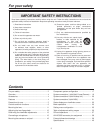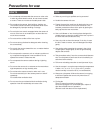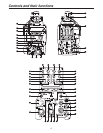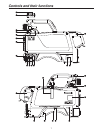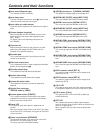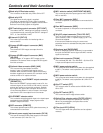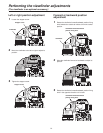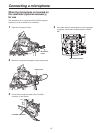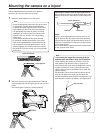
4
Overview
This unit is a new-generation multi-format HD camera that
supports the 1080i format.
It uses a ne
w-generation 2/3-inch 2.2-megapixel IT-CCD
[1920 (H) 1080 (V)] imaging device. This newly developed
CCD employs leading-edge processes and embodies a
fresh look taken at the on-chip lens and CCD structure
to improve the sensitivity, smear and dynamic range by
a significant margin over previous CCDs. Furthermore,
Panasonic’s horizontal single-line readout CCD and
high
-precision signal processing combine to achieve pixel
shifting and a dramatic reduction in moire within the band.
Another salient feature is the newly developed digital signal
processor LSI chip which is mounted in the camera head
and supports 14-bit A/D conversion: This chip processes
the gamma, knee, detail, matrix and other process signals,
delivers the kind of multi-functionality, high quality and
high stability that digital technology alone can provide, and
improves the operating ease.
The 14-bit A/D converter is instrumental in creating a
stable wide dynamic circuit with a high signal-to-noise ratio
from the dark area all the way to the highlights. Using the
dynamic range stretch (DRS) function which adjusts the
gamma correction optimally in real time, both the dark areas
and light areas can now be reproduced with startling clarity.
With buildup applications in mind, the camera head
incorporates a chassis which features a low center of gravity
while at the same time it has a compact size and a low
profile and it offers outstanding operating ease. The range
of these b
uildup applications which include cable-free
connections, mounting of a large-size lens and the shared
use of the large-size lens and barrel lens has been greatly
extended.
The amount of heat generated by the camera has also been
slashed as a result of adopting a low-power-consumption
design for the new circuits and a heat-dissipation design for
the new chassis.
When this Multi-Format Camera is connected to a CCU
(AK
-HCU931, optional accessory), not only can HD signals
be input and output but SD signals (D1, VBS) can be output
and RET/PROMPT signals can be input as well.
The iris, pedestal, gain and other camera adjustments can
be carried out by remote control using a unit such as the
ROP (AK-HRP931) or MSU (AK-MSU935) available as
optional accessories.
Accessories
Operating Instructions ........................................................ 1
Camera No. plate (1 to 12) ........................................... 1 set
Camera hangers .................................................................
2
Screws (M3 8 mm) ......................................................... 4
Mount cap ........................................................................... 1
Features
Newly developed 1080I, 2.2 million-pixel CCDs
incorporated
This achie
ves a high sensitivity that surpasses the
standard sensitivity of F10 and is on a par with SD.
Smear has been cut to 130 dB and the number of
white marks has been drastically reduced by process
improvements.
H-CCD drive is accomplished at a frequency of 74 MHz to
attain a high response and high resolution.
Digital signal processing LSI with high picture quality
featured in the camera unit
After the process circuits, the signals undergo 14-bit,
74 MHz high-picture-quality digital processing, yielding a
high reliability, more functions and enhanced operating
ease as a result.
Multi-functional enhancer
In addition to the many functions such as chroma DTL,
skin DTL and dynamic DTL, there is a choice of 8 boost
frequencies. (For both HD and SD)
Designed to achieve low noise levels of below NC15
Power consumption can be reduced since the fan mode
can be switched according to the situation in which
the camera system is being applied. As a result, the
heat
-dissipation design has also been optimized.
Fuller complement of control circuits and auto setup
(ASU) function
Users can select the standard mode or simplified mode.
Peripheral components
Ease of operation can be further improved by configuring
a system where the Multi-Format Camera is used in
combination with the remote operation panel (ROP) and
master setup unit (MSU).
Data trunk function
T
wo RS-422 and two RS-232C circuits are provided as a
standard feature.
They obviate the need for the cables used with virtual
control, pan-tilt head and lens control, etc.





